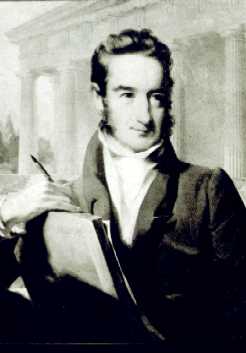 William
Strickland
William
Strickland
William Strickland is one of the foremost architects of the Greek Revival
Era. His designs include the Philadelphia Exchange Building as well as
the Second Bank of the United States,
which is also located in Philadelphia. The Second Bank building is perhaps
the most representative piece of the Greek Revival style that remains today.
Strickland was American born, the son of a New Jersey carpenter. His father
worked on the construction of the Bank of Pennsylvania, which introduced
young William to H. Benjamin Latrobe, the bank's architect. William Strickland
apprenticed under Latrobe for two years. As he grew older, he became a
prominent member of society, joining the American Philosophical Society,
the Musical Fund Society, and the Franklin Institute. In 1815, he successfully
submitted the designs for the Second Bank of the United States, which immediately
accelerated his career in architecture.
Strickland's designs leave a distinguished mark. They include
also St Johns Church, St. Stephen's Church, the Tennessee State Capitol,
the Musical Fund Society Hall. Toward the end of his career, though, Strickland
fell upon hard times. He lost competitions for Girard College to his former
student, Thomas Walter, the Laurel Hill Cemetery, as well as the Franklin
Institute. The Panic of 1837 ended all architectural commissions. He moved
south, and died during the construction of his last design, the Tennessee
State Capitol, and is buried beneath it.
The work of Strickland
made a profound effect on one of America's best known earliest architects,
Thomas Jefferson. Jefferson is most well known for his own private
residence, Monticello, and well as The University of Virginia and the Capitol
Building of Virginia located in Richmond. All of these buildings
share similar characteristics with Strickland's buildings. They are
large, but simple, creating a general effect of elegance. They also
combine aesthetic architectual qualities with engineering accomplishments
of the time. Jefferson would come to look at Strickland's designs
as a starting point for his own.
|
|
|